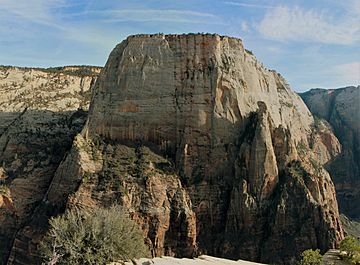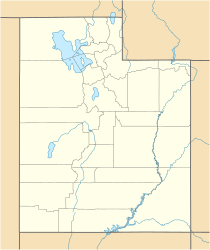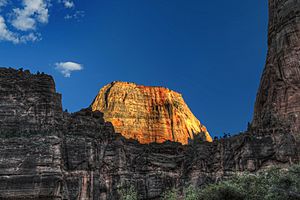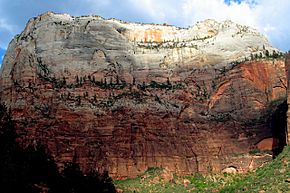Great White Throne (mountain) facts for kids
Quick facts for kids The Great White Throne |
|
|---|---|

Northwest aspect, seen from Angels Landing
|
|
| Highest point | |
| Elevation | 6,747 ft (2,056 m) NAVD 88 |
| Prominence | 664 ft (202 m) |
| Geography | |
| Location | Zion National Park Washington County, Utah United States |
| Topo map | USGS Temple of Sinawava |
The Great White Throne is a huge, white rock formation in Zion National Park, Utah. It's like a giant, majestic mesa, which is a flat-topped mountain with steep sides. This amazing natural landmark is mostly made of white Navajo Sandstone. It stands tall in Washington County, Utah, in the United States.
From the floor of Zion Canyon, near a famous spot called Angels Landing, the north side of The Great White Throne rises about 2,350 feet (716 meters) in just 1,500 feet (457 meters) of distance. Many people see it as a symbol of Zion National Park. You can spot The Great White Throne from most places along the park's scenic drive.
How The Great White Throne Got Its Name
The Great White Throne received its name in 1916. A minister named Frederick Vining Fisher from Ogden, Utah, was visiting Zion Canyon. He was with Claud Hirschi, and together they named many of the park's features.
One afternoon, the setting sun shone brightly on the mountain. Its white rock glowed beautifully. This amazing sight made Fisher say:
Never have I seen such a sight before. It is by all odds America's masterpiece. Boys, I have looked for this mountain all my life but I never expected to find it in this world. This mountain is the Great White Throne.
And that's how this famous landmark got its majestic name!
Climbing The Great White Throne
People can climb The Great White Throne. If a climb is expected to last overnight, climbers need a special permit. You can get this permit from the park's visitor center. This rule helps keep climbers safe and protects the park.
Climate Around The Great White Throne
The best times to visit The Great White Throne are during spring and fall. The weather is usually very pleasant then. The area has a Cold semi-arid climate. This means winters can be cold, but the average temperature in the coldest month is still above freezing.
This desert climate gets less than 10 inches (254 millimeters) of rain each year. Most of the rain falls during spring and summer. Snowfall in winter is usually light and doesn't last long.




